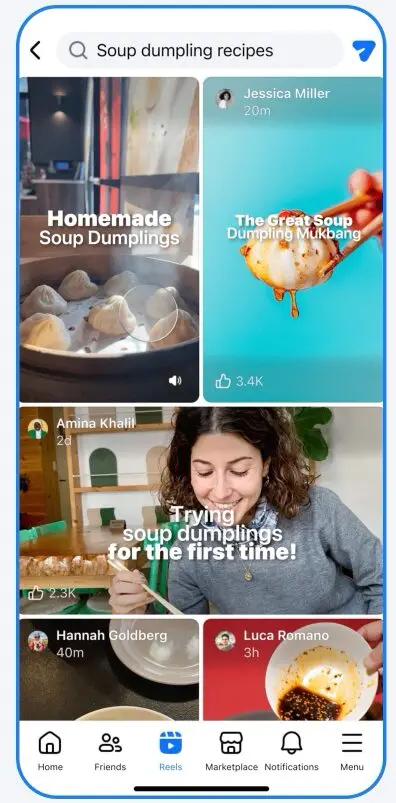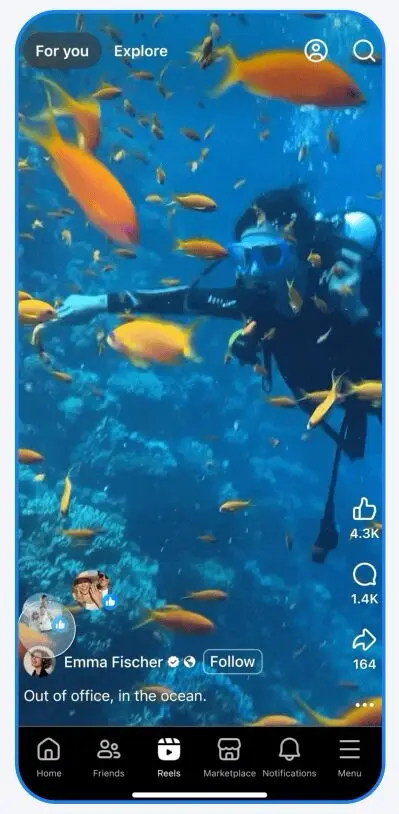- Facebook Reels now displays which videos friends have liked through new “friend bubbles.”
- AI-powered topic search enables users to explore related content directly within the Reels player.
- Meta’s recommendation engine learns preferences faster, prioritizing newer and more relevant videos.
- Updated feedback and Save signals refine personalization and watch-time outcomes.
- The upgrades mark Meta’s effort to combine social connection with algorithmic discovery across Reels and Feed.
AI-driven topic suggestions and visible friend likes make Facebook’s video feed more conversational and community-oriented.
Meta is reshaping the Reels experience on Facebook with a set of updates that merge AI-driven content discovery and social cues. The company announced on October 7 that users will now see “friend bubbles” on Reels and Feed posts showing which videos their friends have liked, alongside AI-recommended topic searches that link to more clips on the same subject.
According to Meta’s product update, the goal is to “make it even easier to connect with friends over the content you care about.” The release underscores Facebook’s long-term ambition to fuse the viral dynamics of Reels with the social interactions that once defined its core experience.
These changes arrive as Meta continues to invest heavily in video-based engagement. Time spent watching videos on Facebook grew over 20% year-over-year in the U.S., and Reels have become a central engine of that growth across both Facebook and Instagram.
A Social Layer for the Algorithm Era
Meta’s Reels expansion reflects a deliberate strategy: Balancing algorithmic precision with relational context. As recommendation engines across social platforms become more powerful, Facebook is differentiating itself by re-injecting the “friend graph” into what has largely become an interest-graph environment.
Rather than focusing purely on what global audiences engage with, the company is spotlighting what your friends engage with — using that as a filter for relevance. This effectively bridges the gap between personalized discovery and social validation, two forces that often compete in modern feeds.
Meta’s statement reinforces this positioning:
“The magic of Facebook has always been in connecting with others. That’s why we’re launching features that make it even easier to connect with friends over the content you care about.”
The shift also strengthens Meta’s advertising and engagement metrics: friend-driven recommendations typically increase watch duration and content sharing, improving the overall stickiness of the platform.
Smarter Recommendations — A Faster-Learning Engine
At the heart of the rollout is a revamped recommendation system that adapts more quickly to user behavior. Meta says it has “invested in improving Facebook’s recommendations and product experience,” resulting in an engine that “understands your interests faster.”
The algorithm now prioritizes fresher content, surfacing 50% more Reels published the same day by creators. This ensures users see more timely material while the system continuously recalibrates around explicit and implicit signals — from likes and shares to saves and “Not Interested” feedback.
The company emphasized that these refinements serve both creators and viewers: creators benefit from faster discovery of their new uploads, while users receive a feed that feels more immediately attuned to their changing tastes.
AI-Powered Topic Search — Discovery Without Leaving the Feed
A second pillar of the update is the rollout of AI-powered topic search recommendations within the Reels player. On certain videos, users will now see tappable topic labels — generated by Meta’s machine-learning models — that lead directly to more Reels on the same theme.
This addition keeps users in an uninterrupted viewing flow and helps Facebook cultivate a more interest-driven discovery loop. Rather than depending solely on passive scrolling, the feature enables active exploration guided by the system’s semantic understanding of video content.
Meta described this as a way for users to “dive deeper into [their] interests… all without leaving the Reels player,” reinforcing the platform’s effort to turn short-form viewing into a continuous, topic-based exploration experience.
Friend Bubbles: Reintroducing the Social Graph
The newly introduced friend bubbles bring a human signal back to the feed. These small icons on Reels and posts show when friends have liked the same content, creating a visible thread of shared interest. Tapping a bubble opens a private chat with that friend, turning passive consumption into potential conversation.
Meta says it has already observed users embracing bubbles “as a way to discover what their friends are into, catch up over shared interests, and maybe even learn something new.” In essence, this brings Facebook closer to its original promise — facilitating genuine social interaction — within the contemporary Reels framework.
The feature also reasserts the role of social proof in recommendation systems: knowing a friend liked a video can boost both perceived relevance and likelihood of engagement, a mechanism long recognized in platform engagement design.
User Controls: Refinement Through Feedback
Alongside the algorithmic and social improvements, Meta is enhancing user agency. Viewers can now directly signal disinterest by tapping “Not Interested” on any Reel, while the Save option has been redesigned to simplify the collection of favorite content in one place.
Meta reports that saves now carry greater weight in the personalization process, describing them as an “explicit indicator of preference” that helps the system fine-tune recommendations. The company also noted that this interaction pattern correlates with increased global watch time.
Why It Matters
Meta’s Reels update represents a strategic attempt to blend algorithmic discovery with authentic social connection, positioning Facebook not only as a video platform but as a socially intelligent content network.
By pairing faster personalization with visible friend engagement, Facebook is reinforcing what made it distinctive in the first place — the idea that entertainment and community can coexist in a single feed. For users, it means a more dynamic, conversational experience. For Meta, it marks another step toward integrating AI, relevance, and relationships into the foundation of its next-generation social ecosystem.





